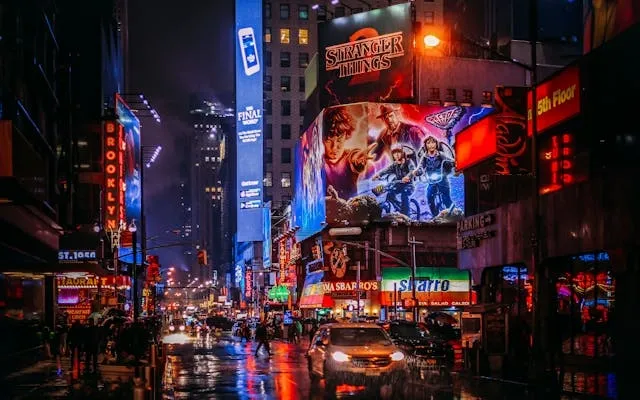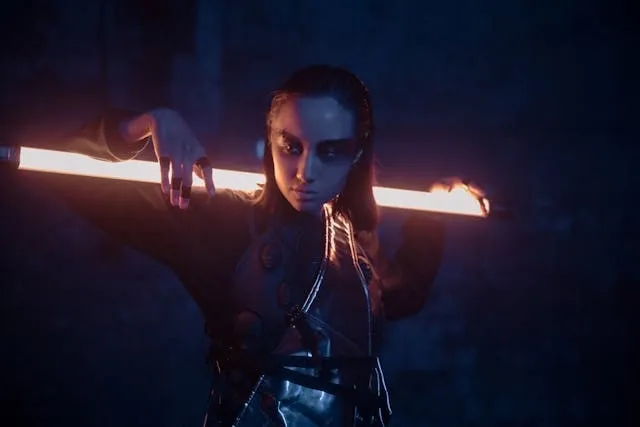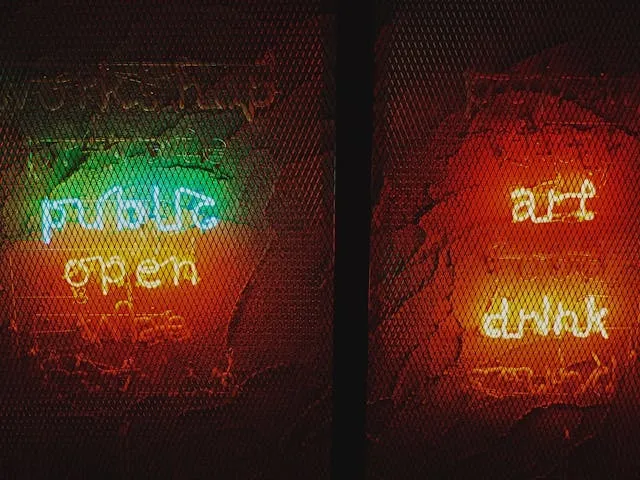When Were Neon Lights Invented (History, Popularity, And Advertising Facts)
The history of neon lights is a fascinating journey of innovation and cultural impact. Born during the early 20th century, neon technology truly transformed urban landscapes and advertising. Its vibrant glow and customizable nature made it a centerpiece of cities all over the world.
The origins of neon lighting date back to scientific discoveries that laid the foundation for this potential. In this post, we explore the history, milestones, and evolution of neon lights into what they are today.

Key Takeaways
- Neon lights were invented in 1910 by Georges Claude after the discovery of illuminating neon gas with electrical currents.
- Neon signs rose to popularity in the 1920s as they became used for advertising and urban designs.
- Advancements in neon technology ensure it is still culturally relevant, even though it has largely been replaced by LED tubing.
- We supply high-quality custom neon LED signs that you can personalize with an array of fonts, colors, and more.
Table of contents
-
When Were Neon Lights Invented?
-
How Did Neon Signs Evolve Over Time?
-
When Did Neon Lights And Signs Become Popular?
-
What Challenges Did Early Neon Lighting Face?
-
How Did Neon Sign Technology Develop Over Time?
-
What Were The First Applications Of Neon Advertising?
-
What Factors Contributed To Neon’s Decline In Popularity?
-
What Are Modern Innovations In Neon Technology?
When Were Neon Lights Invented?
Neon lights were invented in 1910 by a French engineer called Georges Claude. His work was rooted in an earlier discovery of neon gas in 1898 by British scientists William Ramsay and Morris Travers. When electrified, neon gas emits a vibrant red-orange glow, and Claude saw this as an opportunity to create something unique.
Georges Claude introduced his neon lamp to the public at the Paris Motor Show, captivating audiences with its brightness and aesthetic qualities. This invention marked a major technological leap, rooted in advances in electrical discharge technology and the discovery of noble gases.
Patented in 1915, neon lighting soon became commercially viable and quickly found its way into advertising and public displays. From its modest debut to becoming a cornerstone of urban signage, neon lighting revolutionized illumination in cities around the world. Today, you can get more accessible and energy-efficient custom aesthetic neon signs that use LED technology and flexible tubing to operate.

Who Was Georges Claude And What Did He Contribute To Neon Lighting?
Georges Claude was a pioneering French engineer who is credited with the invention of neon lighting. A member of the Académie des Sciences, Claude drew inspiration from earlier experiments with electrical discharge in noble gases. This is how neon signs work, and he developed and patented the technology in 1915, combining the gas’s unique properties with his engineering expertise.
Claude found his first commercial installation in 1912 in a Parisian barbershop. This garnered significant attention for the sign’s striking effect. He would later sell neon signage to larger businesses and his invention became synonymous with cutting-edge advertising.
Claude’s contribution didn’t end with neon lamps, however. He also played a part in innovations like oxygen production and gas-based lighting systems. Though he would eventually be tried for treason for collaborating with German scientists during World War 2, Claude’s work remains foundational in the neon light industry.
How Did Neon Signs Evolve Over Time?
Neon signs progressed from being a technical novelty to a cultural icon over several decades in the 20th century. After Georges Claude patented neon lighting in 1915, the first commercial signs appeared in Europe. By 1923, the phenomenon caught on quickly in the USA. American car dealer Earle C. Anthony famously installed the first neon signs in Los Angeles - a significant step in the technology becoming a cornerstone of urban advertising.
Through the 1920s and 30s, neon signs became inextricably linked to bustling nightlife and modernity, with famous installations in locations like Times Square. Technological advancements brought about new colors beyond neon’s original red-orange glow.
By the middle of the 20th century, neon signs diversified in style and application. They became a part of architecture, art, and retail. They also inspired other signage solutions like lightboxes, contributing to the colorful, luminous urban nightlife we all know today. Neon signs remain a retro-chic symbol that blends nostalgia with timeless artistry.
Make a statement with a unique design that's all your own
Light up your life with our custom LED neon signs!
Order now and let us bring your vision to life
When Did Neon Lights And Signs Become Popular?
Neon lights and signs gained significant popularity during the 1920s and 1930s, when roaring cities and technological optimism reigned supreme. The vibrant neon glow transformed storefronts, bars, and theaters, drawing crowds with that iconic illumination.
Vibrant urban centers adopted neon lighting to define their bustling cityscapes, with notable examples including:
- Paris
- New York
- Las Vegas
Landmarks like the Moulin Rouge and Times Square became prominent showcases for neon artistry. The appeal of the technology lay in the fact it could be shaped into intricate, custom designs to represent brand identities.
In the 1980s, there was a resurgence of neon as it developed a new association with retro and cyberpunk aesthetics. The most iconic neon signs are emblematic of urban nightlife, embodying a blend of sophistication and playfulness that captivates to this day with the emergence of LED neon signs.
What Are The Key Milestones In The History Of Neon Lighting?
The history of neon lighting is punctuated by a number of key milestones in its development, including its invention, the first patent, the introduction to the US, and its global adoption.
- 1898: This is when British scientists William Ramsay and Morris Travers discovered neon gas while studying atmospheric elements.
- 1910: French engineer Georges Claude created the first practical neon lamp, sealing neon gas in glass tubes.
- 1915: Neon lamp technology is patented for production.
- 1923: Neon signs are introduced to the USA via a car dealership installation in Los Angeles.
- 1950s: Neon application boom worldwide, diversifying into decorative and architectural lighting.
After a number of major innovations like adding new gases and phosphor coating to introduce new colors, the technology has evolved substantially. Today, neon signs are considered works of art, and cutting-edge LED alternatives are more commonly used in commercial settings. But these milestones cemented neon lighting’s role as a functional and artistic tool.

What Challenges Did Early Neon Lighting Face?
The early stages of the adoption of neon lighting encountered many challenges. One of the primary difficulties lay in the purity of neon gas and the precision required in the glass tubing. Imperfections frequently led to inconsistent brightness or failures in the tubes, causing neon signs to get hot and generally undermining reliability.
Manufacturing costs were very high at first, so neon lights were only accessible to wealthier businesses. Beyond these technical hurdles, widespread adoption was also hampered by public skepticism. Consumers were unfamiliar with the technology and doubted its benefits over more traditional lighting solutions.
Early signs required careful installation and diligent maintenance, making them less appealing. Regulatory restrictions also arose in many areas as concerns developed about neon’s glare in public spaces. These setbacks may have slowed the adoption of neon lighting, but Georges Claude’s persistence in improving the technology’s durability and showcasing its potential slowly overcame the resistance.
Stand out from the crowd with a one-of-a-kind design
Illuminate your world with our custom LED neon signs!
Order now and let us help you make a statement
Make Your Custom Neon SignsHow Did Neon Sign Technology Develop Over Time?
Neon sign technology has undergone continuous development since its inception. Innovations have ensured neon’s enduring relevance as both an artistic and commercial medium.
Let’s look at some of the stages of its development into what it is today:
- Early days: In the beginning, Georges Claude pioneered neon’s use for advertising, but it was limited to its natural red-orange glow.
- New colors: By adding other gases like argon, and introducing coatings inside the tubes, a broader spectrum of colors emerged.
- Technological advancements: Innovations refined the materials used in the glass tubing and electrodes, enhancing durability and reducing maintenance costs.
When flexible LED neon tubing was invented, the door was opened to more intricate designs and larger-scale installations. Today, LED neon lighting integrates features like programmable systems that enable dynamic displays with myriad shifting colors. Eco-friendly technology has also improved the environmental impact of these popular lighting solutions.
What Was The First Color Of Neon Light?
The original color of neon light was a brilliant red-orange glow from the electrified neon gas. There have been numerous studies to measure the color and light output of neon tubes, but the original hue was produced due to the specific wavelengths emitted when neon atoms are ionized.
The iconic glow captivated audiences when it was introduced in 1910 in the first neon lamp. Over time, additional colors were developed by incorporating other noble gases, such as:
- Argon
- Krypton
- Helium
Coatings on the inner glass walls of neon tubing further expanded the spectrum of available colors to include blues, greens, yellows, and purples. Despite the availability of modern neon light colors, the original red-orange remains the iconic look. As such, it is often the popular choice for nostalgic or retro-themed signage, invoking the early days of neon’s technical prominence.
What Were The First Applications Of Neon Advertising?
The initial applications of neon advertising revolutionized how businesses drew attention to their establishments. In 1912, Georges Claude created a neon sign for a barbershop in Paris, marking the technology’s debut in commercial advertising. Its vivid glow immediately captivated onlookers, laying the foundation of neon as a marketing tool.
By 1923, neon advertising arrived in the United States, with a Los Angeles car dealership commissioning two neon signs that quickly became local attractions. It wasn’t long before major brands recognized neon’s potential for enhancing visibility and brand recognition, spurring widespread adoption.
Neon signs would come to illuminate urban cornerstones like:
- Theaters
- Diners
- Retail stores
They became a dynamic visual language in bustling cities around the world. The medium has a unique ability to capture attention in all weather conditions. This ensured its lasting popularity and, today, you can work with us to make your own neon sign from cutting-edge LED neon flex tubing.
Why Was Neon Lighting So Effective For Advertising?
Neon lighting revolutionized advertising with an unparalleled ability to captivate attention. The vivid brightness and customizable shapes of neon signs gave businesses a novel solution to stand out in a way that couldn’t be matched by the likes of custom vinyl banners.
Neon’s glow cuts through darkness, so it is ideal for nighttime advertising and ensuring visibility even from a distance. With versatile design options, companies could use them to create logos, slogans, and other imagery that resonated with their audiences. The vibrant colors became synonymous with modern nightlife and innovation.
Unlike traditional signage, neon offered a dynamic appearance that evoked energy and excitement. Even decades later, neon signage stands as an effective tool for establishing brand identity and making memorable customer impressions.
Create a design that's uniquely yours
Brighten up your space with our custom LED neon signs!
Order now and let us help you add a pop of color
What Factors Contributed To Neon’s Decline In Popularity?
The decline in the popularity of neon lighting occurred due to several factors, including the emergence of LED technology, shifting architectural trends, and regulatory restrictions.
Let’s look at them in more detail here:
- LED technology: The advent of LED neon flex tubing provided a more energy-efficient and cost-effective alternative. When you look at LED neon vs glass neon lights, the former requires less maintenance, has a longer lifespan, and offers more flexibility for dynamic displays.
- Architectural trends: A shift towards minimal aesthetics in architecture and design clashed with the bold, colorful look of neon signage.
- Regulatory restrictions: Some areas introduced restrictions on neon sign usage, further limiting its appeal.
- Energy consumption: As people became more aware of the importance of energy efficiency, the perception of neon took a hit as more sustainable alternatives emerged.
Nostalgia and artistic value preserve the niche appeal of neon, but it is now more commonly associated with retro aesthetics.

What Are Modern Innovations In Neon Technology?
Certain modern innovations revitalized neon technology. Advances in sustainable gas usage and integrations with LED technology have been beneficial. Let’s look at the modern neon light market a little:
- LED neon: Also known as faux neon, these products replicate the glow of classic neon with superior energy efficiency and durability. You can work with us to create custom LED signs with an array of colors and fonts available.
- Programmable neon: These products allow for dynamic animations and colors shifts for an even more customizable solution.
- Gas and coatings: Advances in the technology of traditional neon signs have increased the brightness and color range of authentic neon lights.
- Sustainable practices: New techniques have been developed involving eco-friendly gas usage and recyclable materials.
- Interactive installations: These allow users to control neon displays via smartphones or sensors to make neon more immersive.
Create a unique design that captures the essence of your love story
Add a touch of romance to your special day with our custom LED neon signs!
Order now and let us help you make your wedding day unforgettable.
Make Your Custom Neon SignsFrequently Asked Questions About When Were Neon Lights Invented
When Were Neon Lights Invented And What Was Their Significance?
Neon lights were invented in 1910 by Georges Claude, revolutionizing illumination in advertising by bringing a vibrant glow that stands out in a variety of conditions.
When Did Neon Lights And Signs First Become So Popular?
Neon lights became increasingly popular through the 1920s and 30s, particularly in urban settings like Paris, New York, and Las Vegas. They became symbols of modernity, synonymous with nightlife and advertising.
